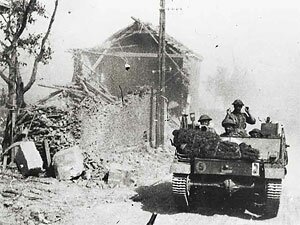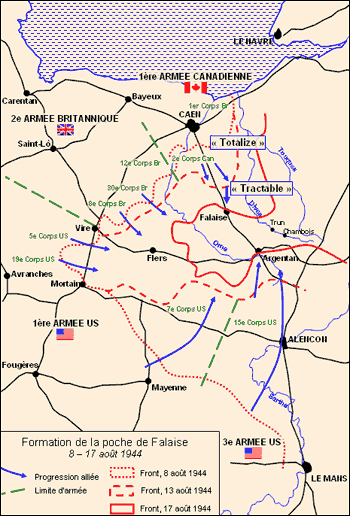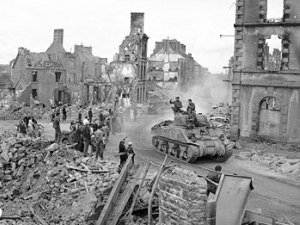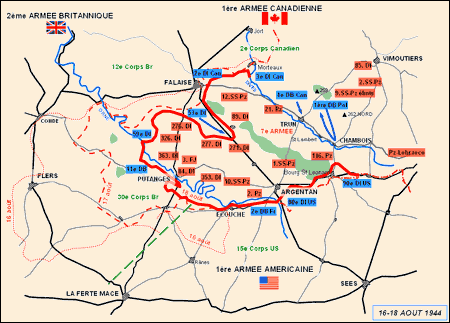The battle
August 16th – 18th, the encirclement
Wehrmacht drives back
 August 17th, 1944 - a bren carrier of the 1st Polish armoured divis-
August 17th, 1944 - a bren carrier of the 1st Polish armoured divis-
ion advances in Fontaine-les-Basset. Objective: Chambois. Source:
Orne departmental records. Despite Falaise had been the objective of two major operations Totalise and Tractable, its capture occurred too late to achieve an encirclement of German forces between Falaise and Argentan, as initially planned by Bradley and Montgomery. Indeed, August 16th, German forces started to drive back from the mortal trap the allies wished to prepare them. After having sacrified his best troops to keep the front line against all odds, Hitler validated on August 16th a first movement of retreat on the Touques, then the Seine, an order that was anyway anticipated by senior officers of OB West on the field. August 17th, facing negligible allied opposition, a first wave of german units managed to retreat behind Orne river... From now on, the junction of the British and the Americans must take place more east, or the trap will fail!
In order to prevent expected german escape, 2nd Canadian corps redirected 1st Polish and 4th Canadian armoured divisions southeast, in order to find a crossing on the Dives river. On August 15th, those units of the 1st Polish armoured division which were not taking part in the fight for Potigny rolled on from the positions conquered the previous day by 3rd and 4th Canadian divisions between Assy and Rouvres, and reached Dives river in Jort. While Cromwells from 10th PSK succeeded in repulsing an armoured counter-attack, a reconnaissance patrol led by lieutenant Maksymowicz captured some Osttruppen soldiers, who indicated a ford allowing to get on the opposite bank while avoiding the bridges mined beforehand by German engineers. 10th PSK managed to cross the river shortly after and established a bridgehead on he opposite bank: the long avaited breakthrough was achieved! The Canadian Corps could from now on roll on Trun and link with the Americans.
After their breakthrough in Jort, Poles advanced south to Barou en Auge. August 16th in the evening, 24th lancers regiment lost several tanks when pushing back a counter-attack near Morteaux-Couliboeuf, before it was finally reached by the 4th Canadian armoured division. August 17th, Poles advanced beyond Louvières and were firmly installed in the evening on the hills covering northern approaches to Trun. 
On the southern flank of the forming pocket, the 2nd Free French armoured division (gen. Leclerc), which had fought to liberate Alençon then Sées, approached Argentan as early as August 13th. However, a controversed order of Bradley stopped on this date and for three days the advance of the whole US 15th Corps, allowing thousands of Germans to leave the pocket. Worse, it allowed Hitler to order 116. PzD and some remains of Panzergruppe Eberbach to reinforce southern face of the pocket, a move that would considerably increase german opposition in this area.
August 16th, the thrust of Americans resumed, direction north-east. The Falaise – Argentan project being now obsolete, Allied staffs planned to carry out the closing of the Falaise pocket between Chambois and Trun. Bradley reshuffled his organisation, as US 5th armored and 79th infantry divisions were redirected east, the task to close the southern pincer of the pocket being assigned to US 80th and 90th infantry, and French 2nd armored division (5th Corps).
Because of thickened german defenses, advance of 5th Corps was now far more costly it has been expected. Fresh and lacking experience 80th infantry division received a bloody lesson in Argentan, and was unable to capture the city despite several assults launched between August 16th and 18th. More experienced 90th infantry division was closing on Bourg-Saint-Léonard, but get stopped on the hills surrounding the city by furious german couter-attack and despite close suport of 2nd free french armored division which was clearing the Gouffern forest.
Advance on Chambois
 While Poles and Americans were advancing on Chambois, british
While Poles and Americans were advancing on Chambois, british
divisions pushed german troops eastward. On this picture, one can
see 11th armoured division in Flers, August 17th, 1944. IWM B9330
In the night from August 17th to 18th, aware that time was a key factor of success, Poles resumed their attack yet their units have not been reorganised nor resupplied after previous fights. Cutting german-controlled Trun – Vimoutiers road, a tactical group “Koszutski” (2nd armoured regiment and 8th rifle battalion) had been directed towards Chambois. In the darkness, led by a guide who misunderstood their request, the Poles found themselves not in Chambois, but in Champeaux, running straight into headquarters of 2nd SS-PzD…A violent fight developed, and only the quick and resolute counter-strike led by 8th rifles allowed the group to disengage around noon.
However, in the morning, the plans had changed. Maczek, commanding 1st armoured division, noticed on his maps the first elevated grounds of the Auge country, which seemed easier to defend than the valley the Dives. Because of its characteristic form, the hill he chose as pivot for his division’s defensive lines was called Maczuga (the mace). It is in this precise direction that was redirected the Koszutski group. Running short on supplies, forced to progress through constant harassment of German retreating units, it could not achieve its goal and had to stop on hill 240, four kilometres short of its objective, at the end of the day. On its side, the 10th PSK performed the outstanding mission to cross through German lines, and pushed as far as the immediate outskirts of Chambois. It carried out its scouting mission successfully, then returned to his starting point.
When Poles were trying to get rid of german opposition in Les Champeaux, Canadians liberated Trun in the morning of August 18th. The 4th Canadian armoured division detached then an armoured column made up of South Alberta Regiment and Argyll and Sutherland Highlanders under command of major D.V. Currie, with mission to seize the bridge of Saint-Lambert, then to establish contact with Americans expected to arrive trom south. If carried out, this movement would close the last crossing points on the Dives. In the afternoon, the Currie force approached the western end of the village, but was engaged by German anti-tank guns positioned in the village. After loosing two tanks, Currie formed a defensive perimeter at the entry of the hamlet, on hill 117.

American situation was still ambivalent. 80th infantry division, now supported by 610th tank destroyer battalion, lauched its third attack on Argentan and managed to enter the city as far as the train station, where its advance stalled. Tough Ombres (90th ID) chased Germans from Bourg Saint-Léonard and advanced as far as Sainte-Eugénie, Bon Menil and Fougy in spite of determined enemy resistance by the end of August 18th. However, Germans couter-attacked again and a bloody fighting developped in Bourg-Saint-Léonard until the next day.
German forces still present in the pocket took profit of this situation. Despite British 11th armoured, 53rd and 59th infantry divisions were pressing them constantly on the western flank of the pocket, retreat was for the moment well organised, rearguard units keeping a firm frontline. Although pushed back from Trun, 2nd SS-PanzerKorps finished to cross the Dives at midday and headed on Vimoutiers. Its two organic divisions (2nd SS-PzD and 9th SS-PzD) had received the decisive mission to reorganize in the Auge country, in order to counter-attack the allied forces which endangered the escape roads to the remnants of German 5th and 7th Armies.













 www.evl.pl
www.evl.pl